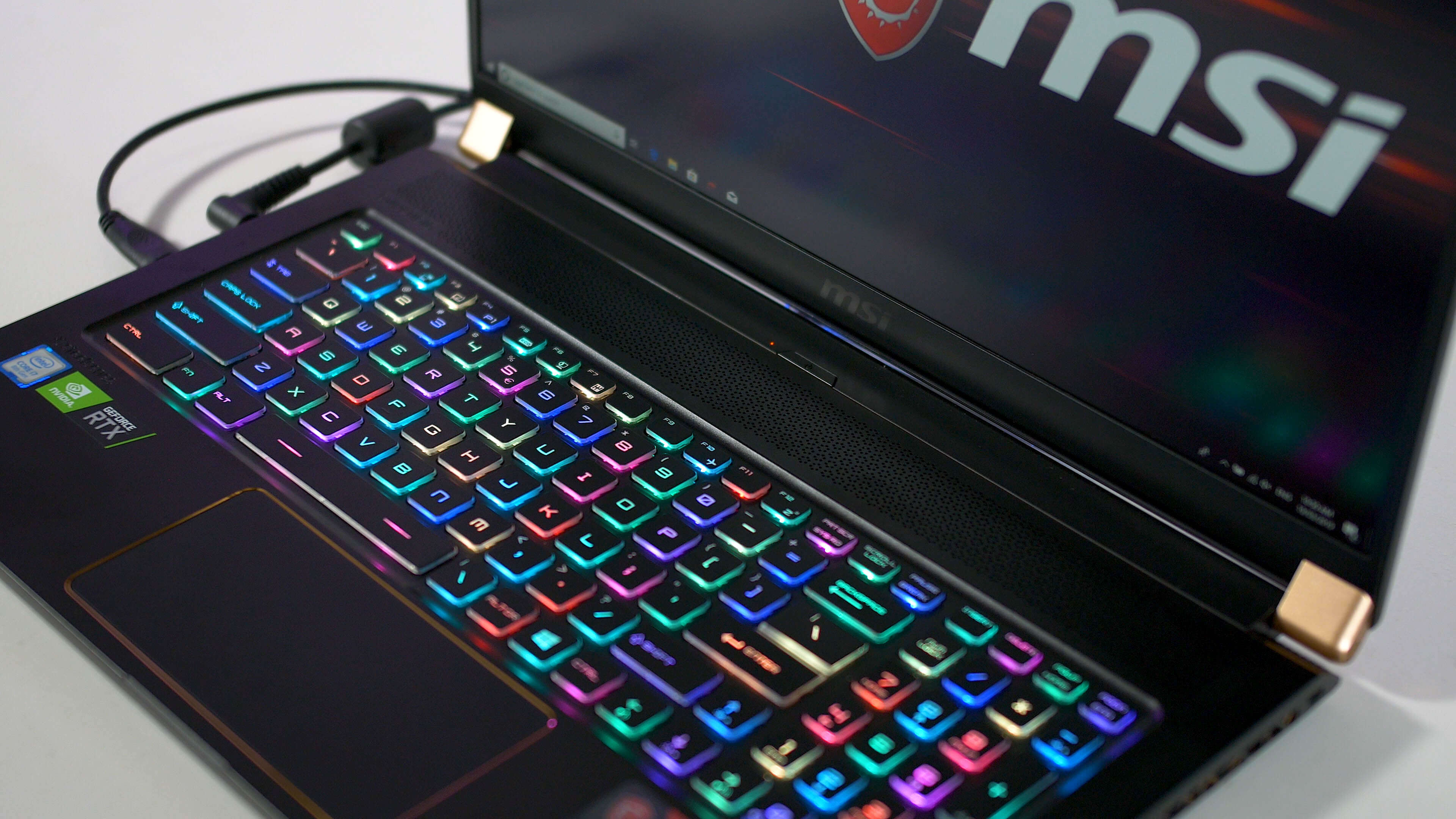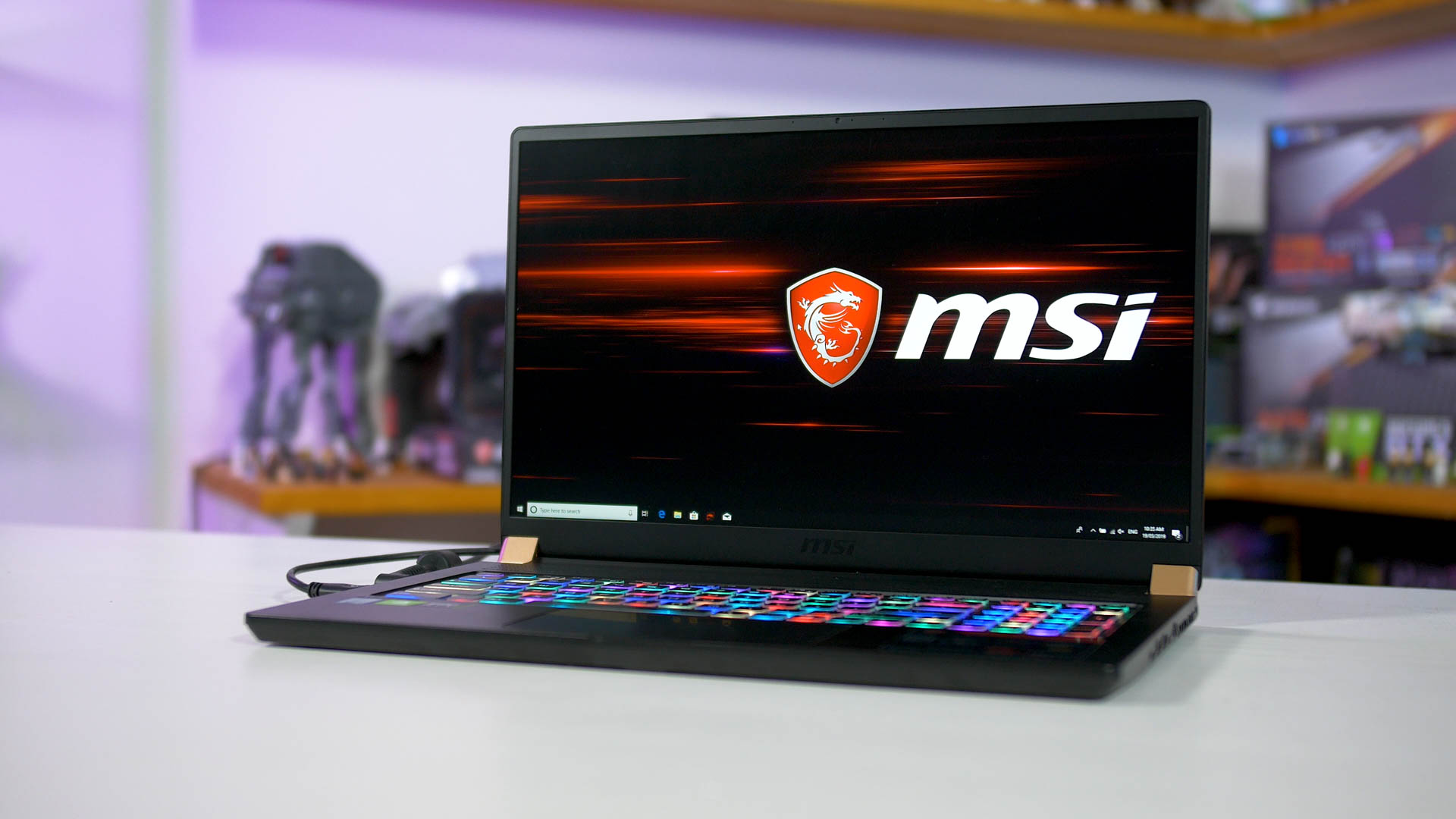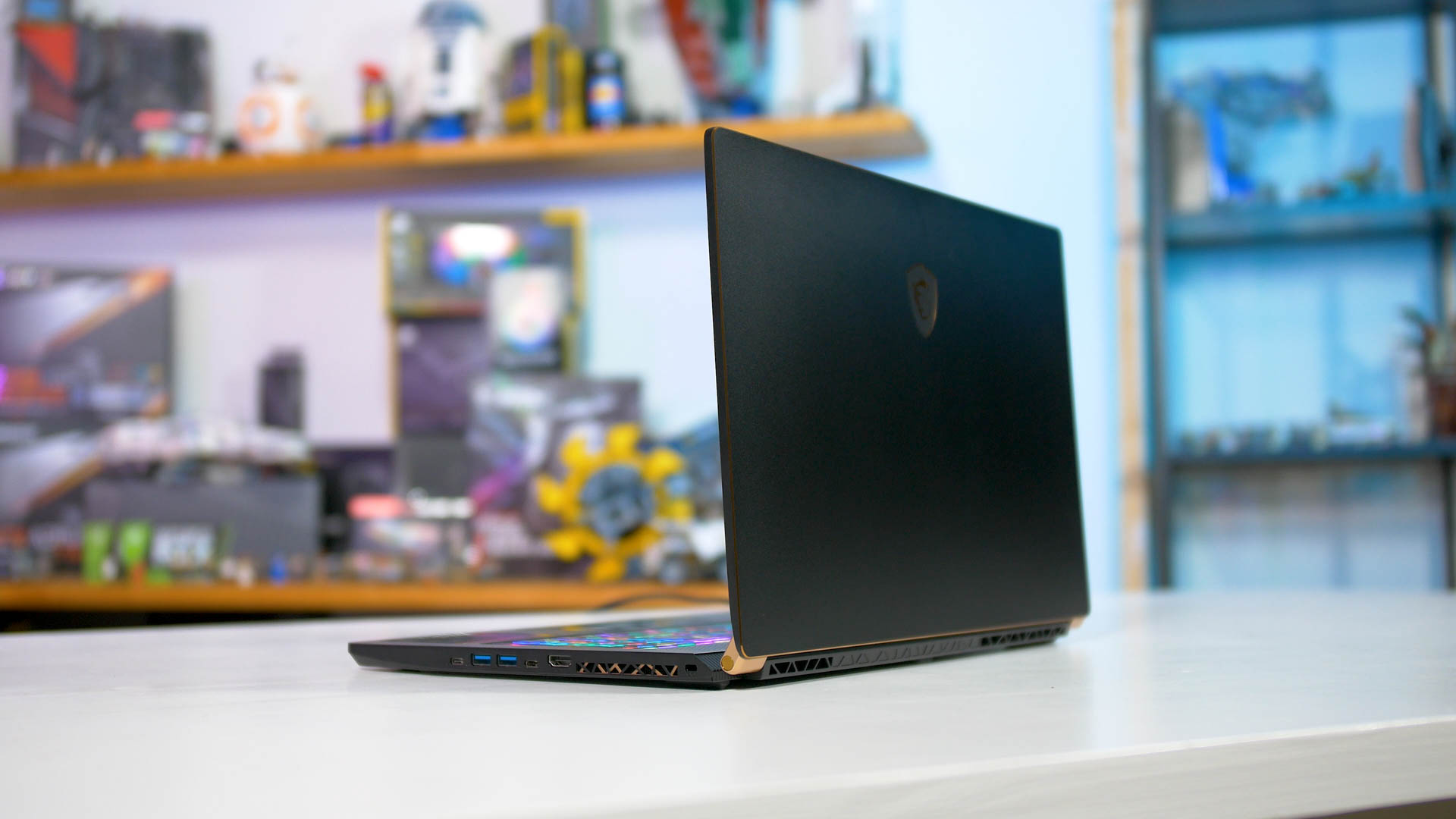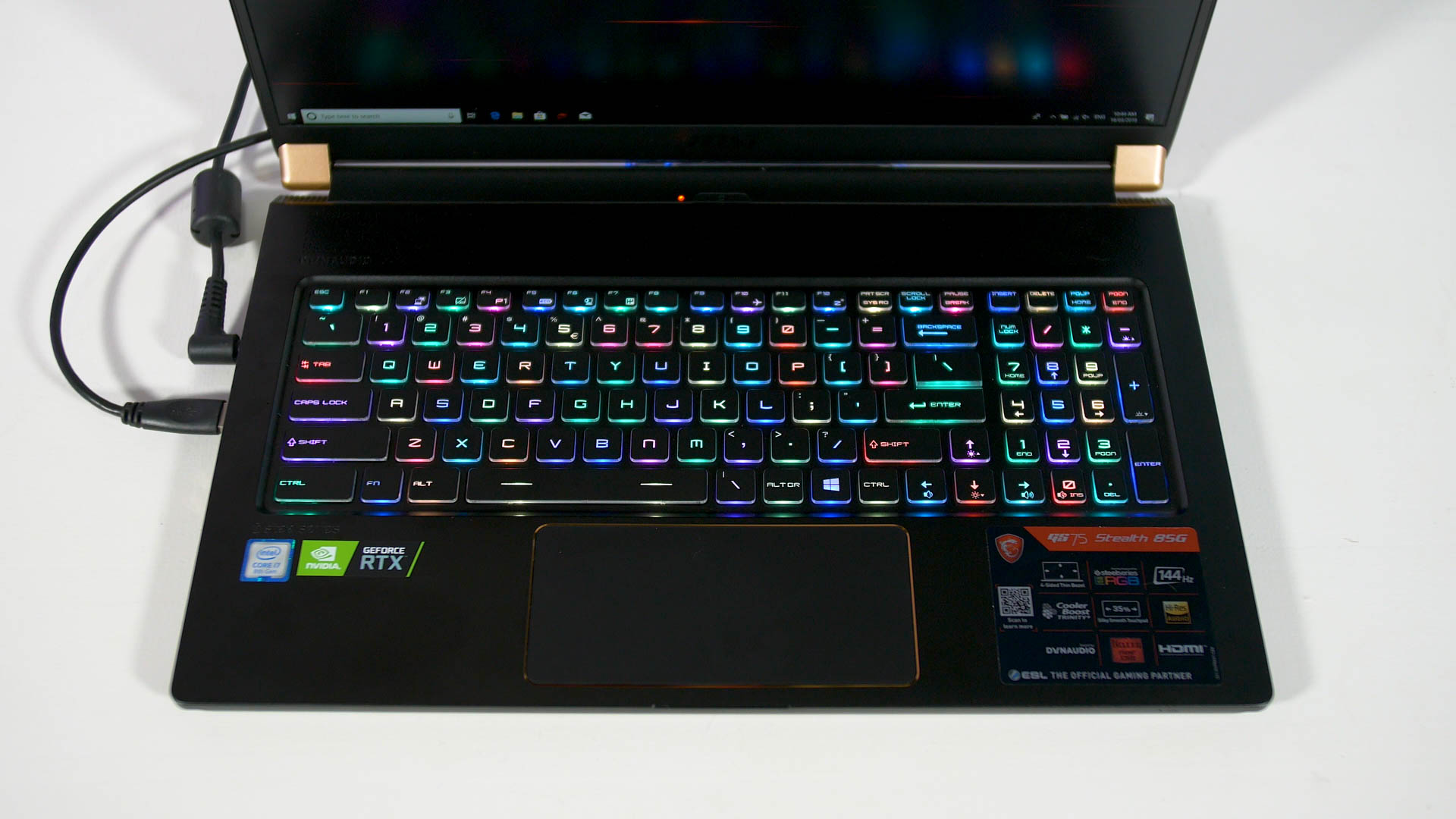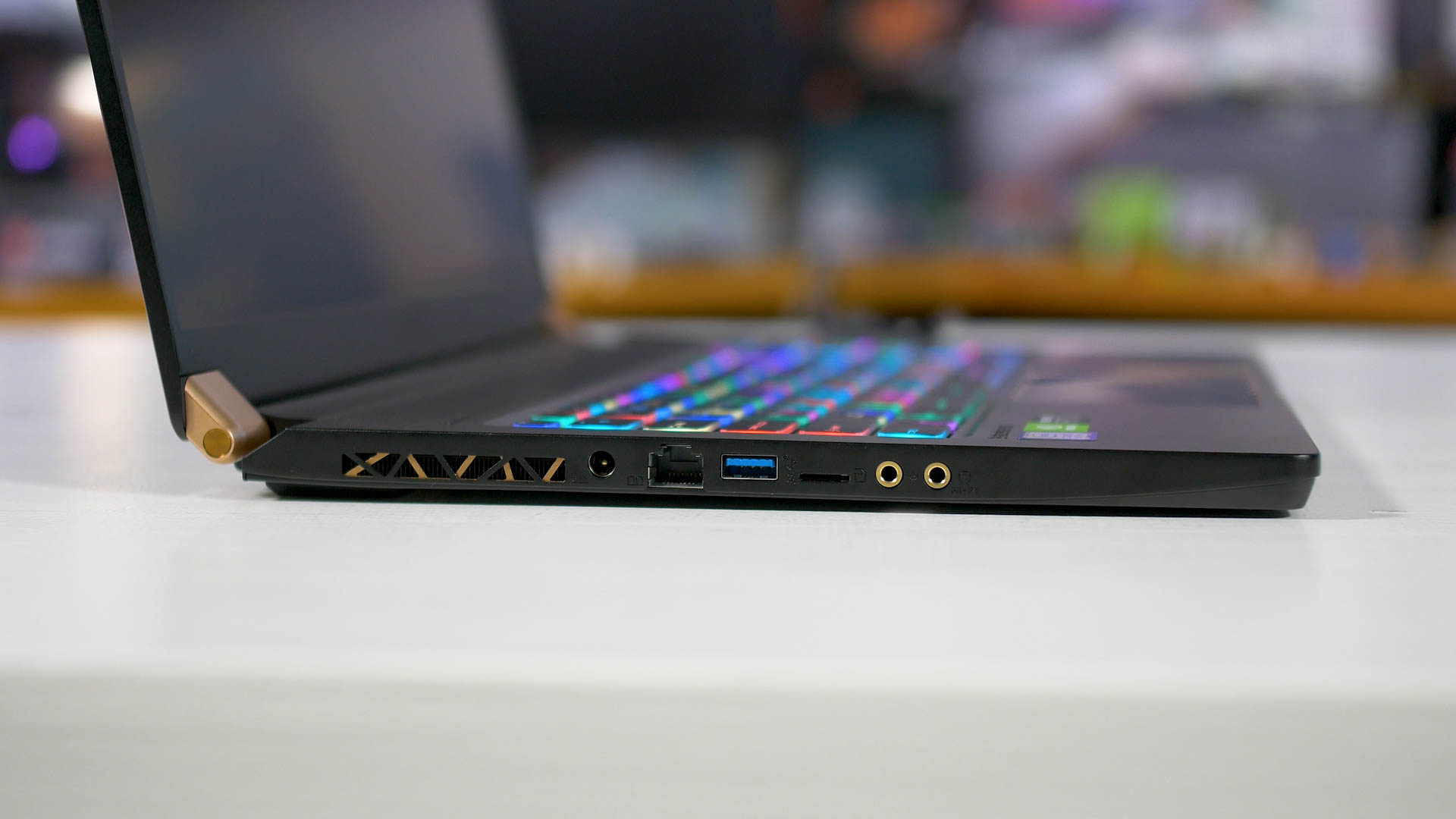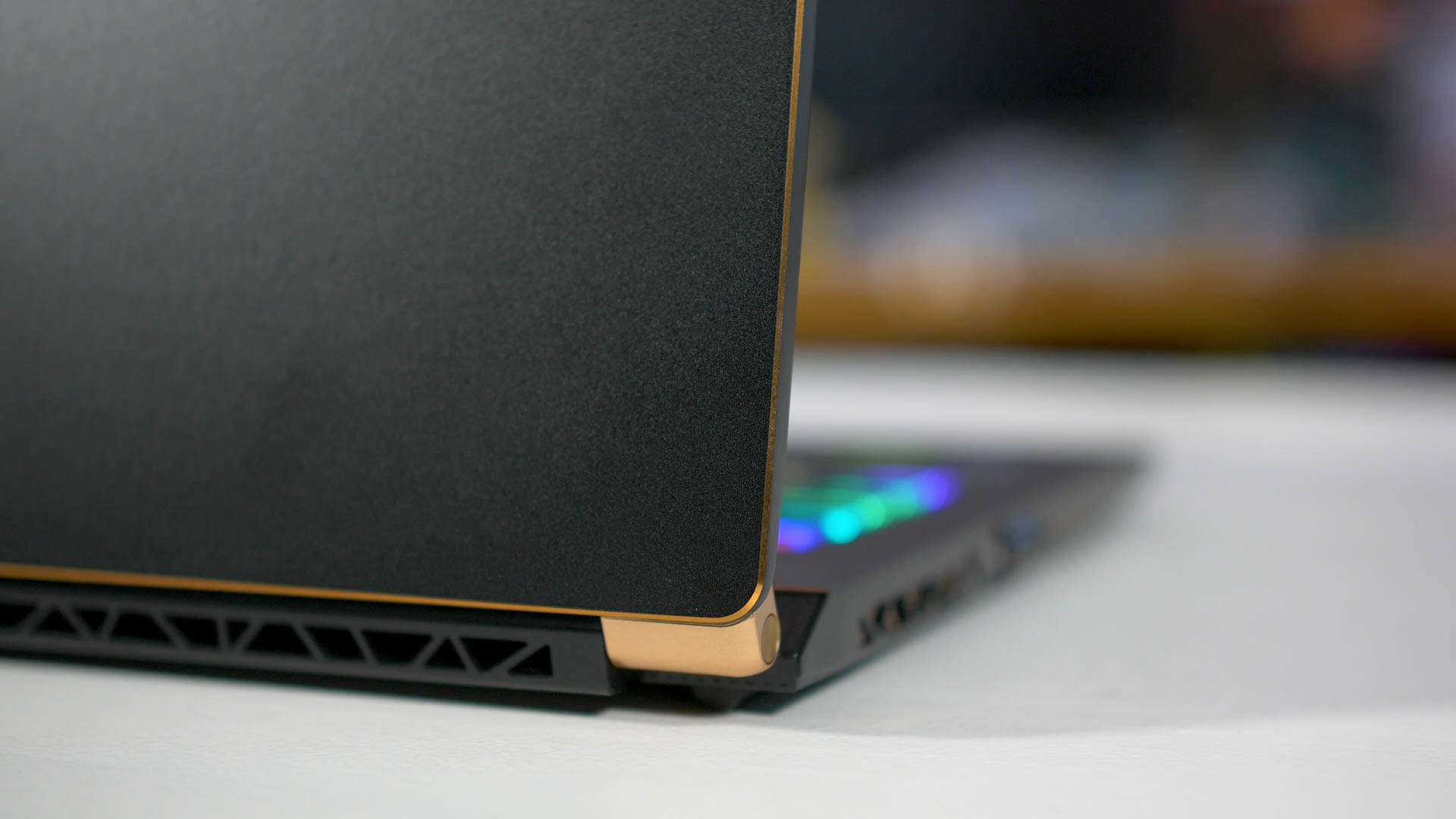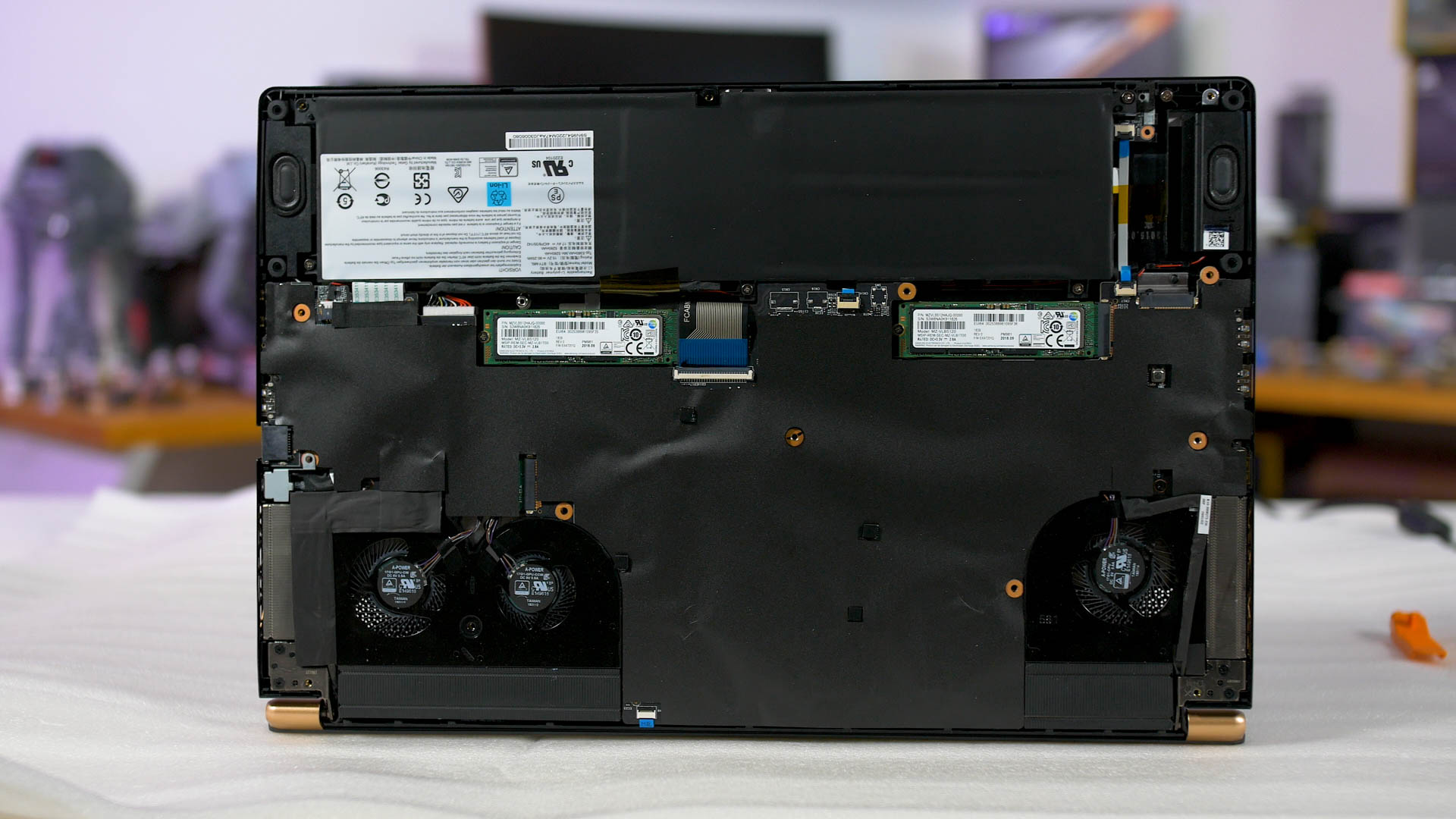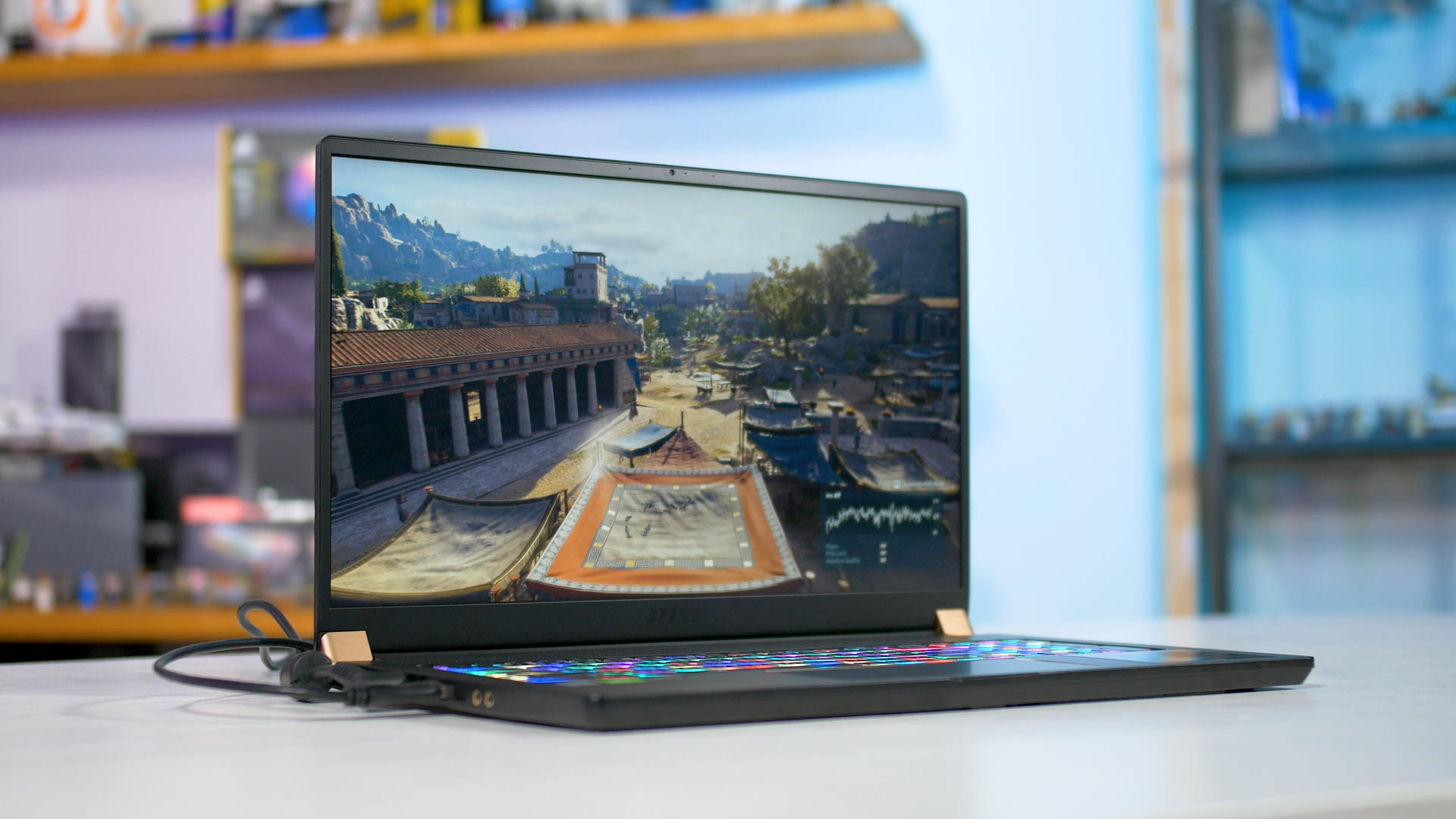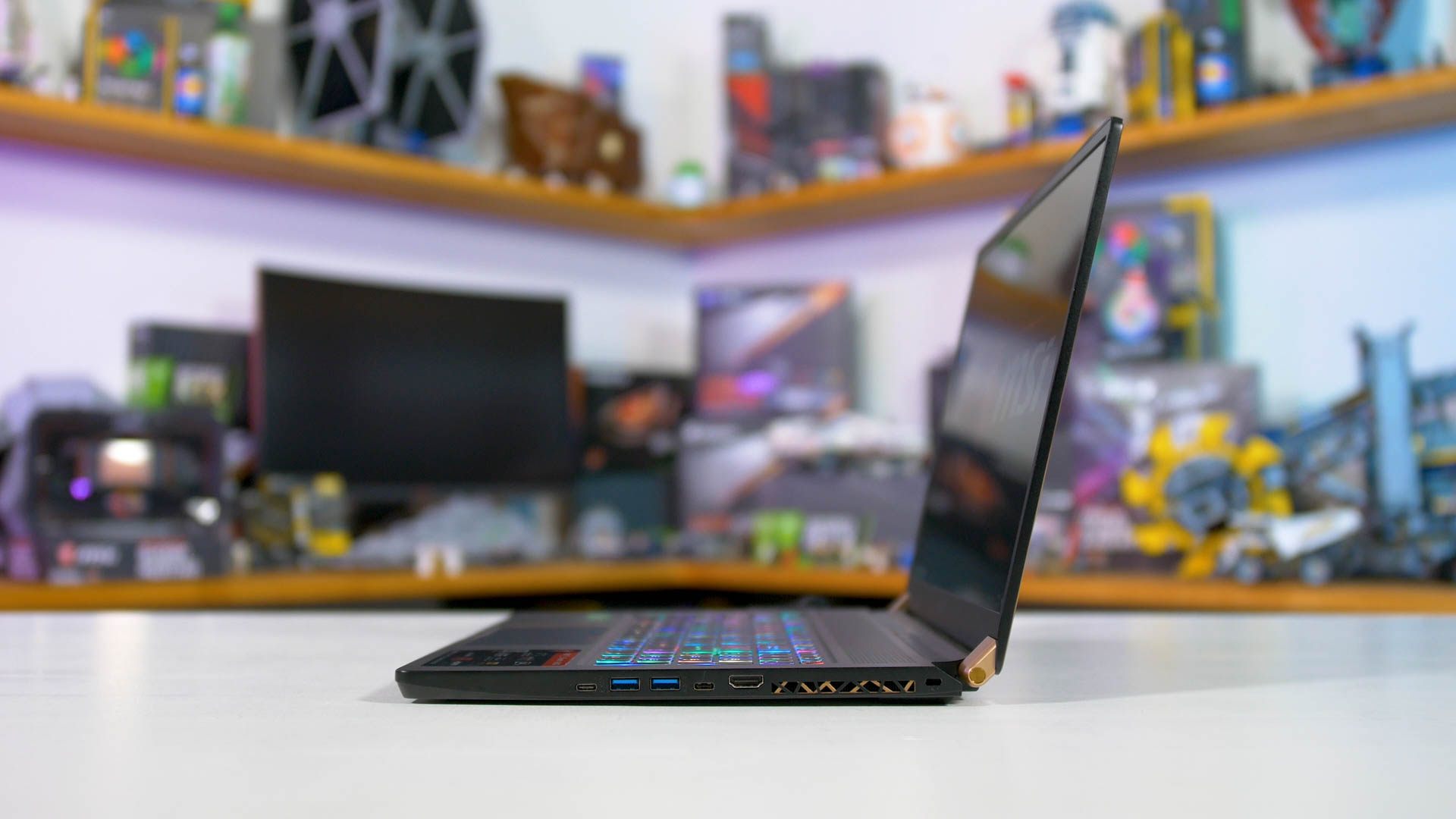Today we're checking out the top-of-the-line MSI GS75 Stealth 8SG, one of a number of new RTX-powered gaming laptops from MSI. As this beast fits into their Stealth line, it's designed to be a slim and light portable gaming system, with the GS75 branding indicating it's their 17-inch model. Previously we reviewed the GS65 and really liked it, so we were definitely keen to check out the larger model equipped with a new GPU.
The GS75 Stealth 8SG model we were sent for testing is the most powerful unit available equipped with an RTX 2080 Max-Q GPU. There are also models available with the RTX 2070 Max-Q and the RTX 2060. Each variant of this laptop with a different GPU is then available with different RAM and storage configurations, in our case we received 32GB of dual-channel memory and a dual 512GB SSD setup in RAID 0.
The rest of the hardware is shared among the configurations: you get an Intel Core i7-8750H processor, the standard for gaming laptops. There's also a 17.3-inch 1080p 144Hz "IPS-level" display, and an 82 Wh battery.
The design of the new GS75 is nearly unchanged from MSI's previous versions, and that's a good thing.
It means we're still getting the excellent metal near-unibody build with beautiful copper gold highlights. This is one of the best looking gaming laptops on the market, so wholesale changes really aren't required. It's a sleek laptop with a nice minimalist style.
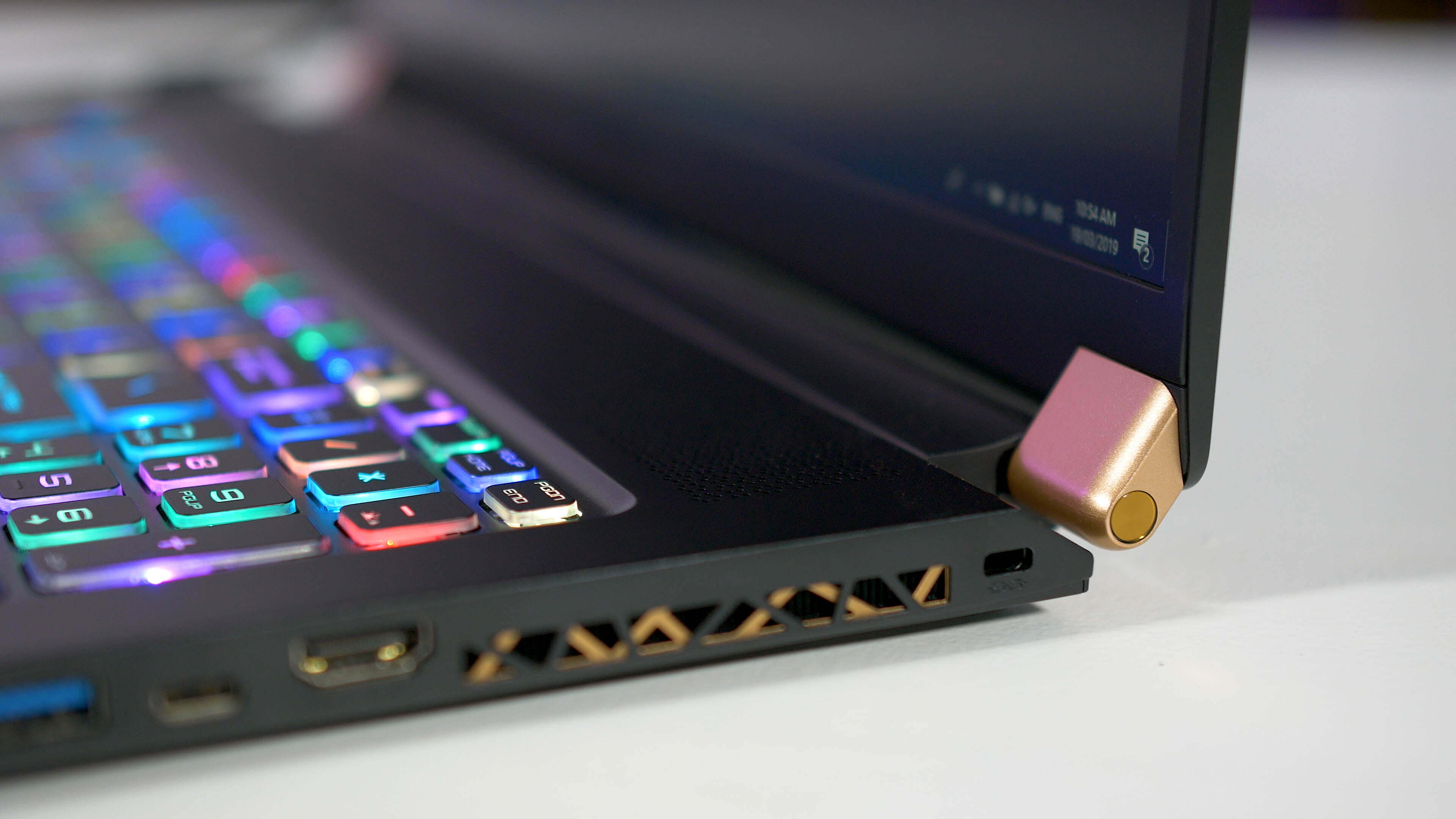
We're still getting MSI's version of a slim-bezel laptop, even at 17-inches, with the tiny webcam positioned above the display. It's not the slimmest bezels available on any laptop but it certainly feels like the display is taking up most of the room available to it, and it keeps the laptop compact overall. In fact, at just 19mm thick and 4.96 lbs heavy, it's a very portable chassis for a 17-inch beast, coming in slimmer and lighter than your typical 15-inch system.
The keyboard is the same SteelSeries unit as previous MSI laptops. It's not one of our favorites, the tactile response is spongy and not particularly satisfying, although travel distance is fine. It does come with a full numpad as we'd expect for a 17-inch laptop, although the inclusion of full size arrow keys has truncated the right shift key which may annoy some users.
The good news is you do get per-key RGB backlighting, which is becoming more widespread among high-end gaming laptops. You also get a sizable trackpad with excellent responsiveness.
I/O is the usual affair: three USB 3.1 gen2 type-A ports, two USB-C ports, one is Thunderbolt 3 and the other USB 3.1 gen 1. There's Ethernet, a microSD card slot and HDMI as well plus dual 3.5mm audio jacks. Our only concern here is the amount of ports on the right side of the laptop, such as HDMI, which makes it a little awkward to have a mouse there if several things are plugged in.
Performance
Let's talk about performance now, and as a quick reminder, everything here is based on our experience with the RTX 2080 Max-Q model. With that said, we do have comprehensive benchmark reviews of the RTX 2070 Max-Q and RTX 2060 that should apply to this laptop's other GPU configurations.
As with many gaming laptops, there are several performance modes and fan profiles to choose from. Throughout this review we found the top Turbo performance mode to perform the best, because it overclocks the GPU by 100 MHz compared to the default Sport mode. We also found that while there are four fan modes, the auto mode performed just as well as the other performance-oriented modes, with very little change in fan speeds when gaming. This is great to see because auto also quietens the fan significantly during less intensive tasks like web browsing.
Throughout this review we've used the combination of the Turbo mode and Auto fan mode.
The laptop comes with one of Intel's six-core Core i7-8750H processors, which is widely used across gaming laptops, particularly in this form factor. We've tested this CPU many times before so we're not going to rehash a ton of benchmarks for this laptop in particular, if you're interested, go back and check out our original review of this mobile CPU.
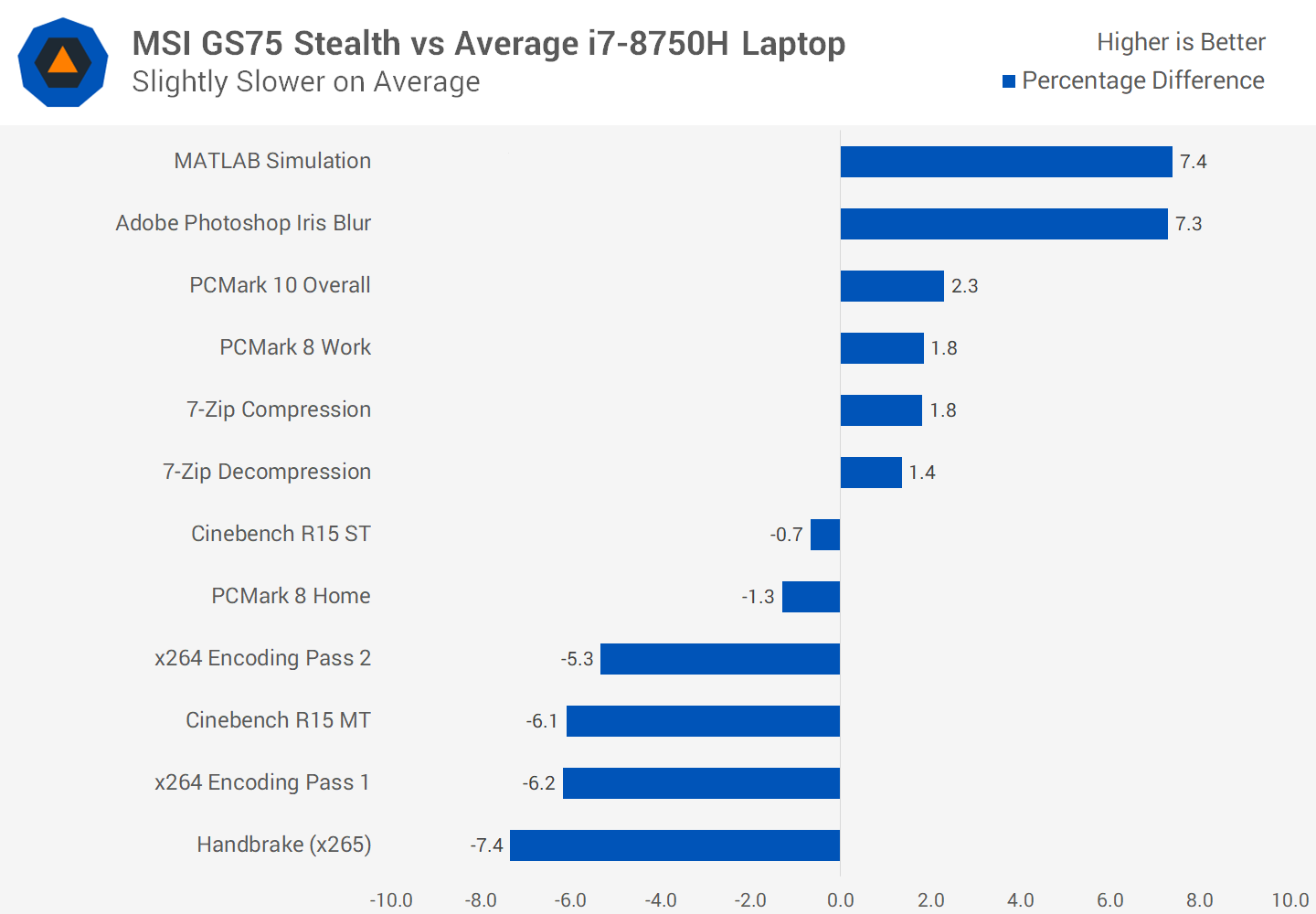
In terms of CPU performance, all we're looking for is to see whether the MSI GS75 Stealth performs especially well (or not) compared to the average result from all the Core i7-8750H laptops we've tested so far. It does depend on the workload, but the GS75 is a little slower on average, especially in longer workloads like Handbrake and x264 encoding where it's about 6 percent behind. With that said, it's a little faster shorter tasks like 7-Zip and MATLAB so this isn't a bad result overall, it's just can't sustain as high performance for as long as some of the beefier laptops we've tested.
If you are coming from a quad-core laptop, something using a Core i7-7700HQ for example, you can expect the GS75 to deliver pretty sizable gains: 40% in workloads like x264 encoding, and over 50% in 7-Zip, with a handy 10% improvement in single-threaded tasks as well. Jumping up to six-cores is a good move, especially if you do a lot of multi-threaded work, and it can help alleviate a few bottlenecks in some games.
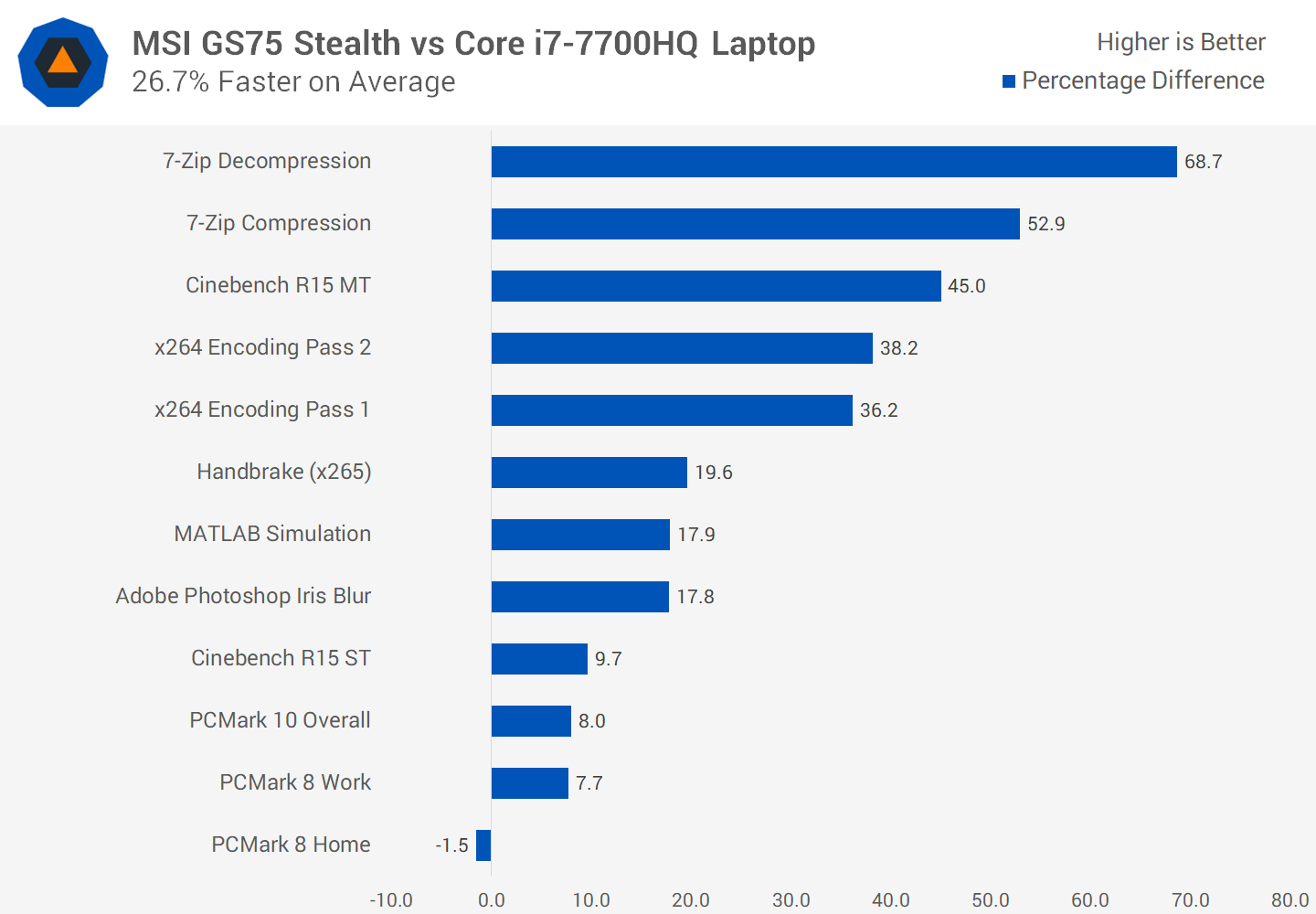
Gaming Performance
We're sure most of you reading this review will be more interested in gaming performance though, given that's the key selling point of getting a unit with a GPU as fast as the RTX 2080 Max-Q. If you're after a detailed performance breakdown of this GPU, please check out our full review that focuses on the RTX 2080 Max-Q, where you'll see some individual game breakdowns and discussion. It's safe to say this GPU is very capable of gaming at 1080p at high frame rates, which makes use of this laptop's 144 Hz display.
The GS75 Stealth uses the regular 80W configuration of the RTX 2080 Max-Q, not the faster 90W version, so the data to look at in our GPU review is for the standard configuration. But that data only refers to how this laptop performs in the default Sport performance mode, if you enable the Turbo mode, the GPU gets a 100 MHz factory overclock of sorts, which improves performance over the 'standard' RTX 2080 Max-Q configuration.
We're sure most gamers will want the best performance straight away, so this factory OC mode is something you should use to get the most out of the laptop. As far as thermals and noise are concerned, the Turbo mode didn't impact either significantly, so we don't see a reason not to use it for gaming.
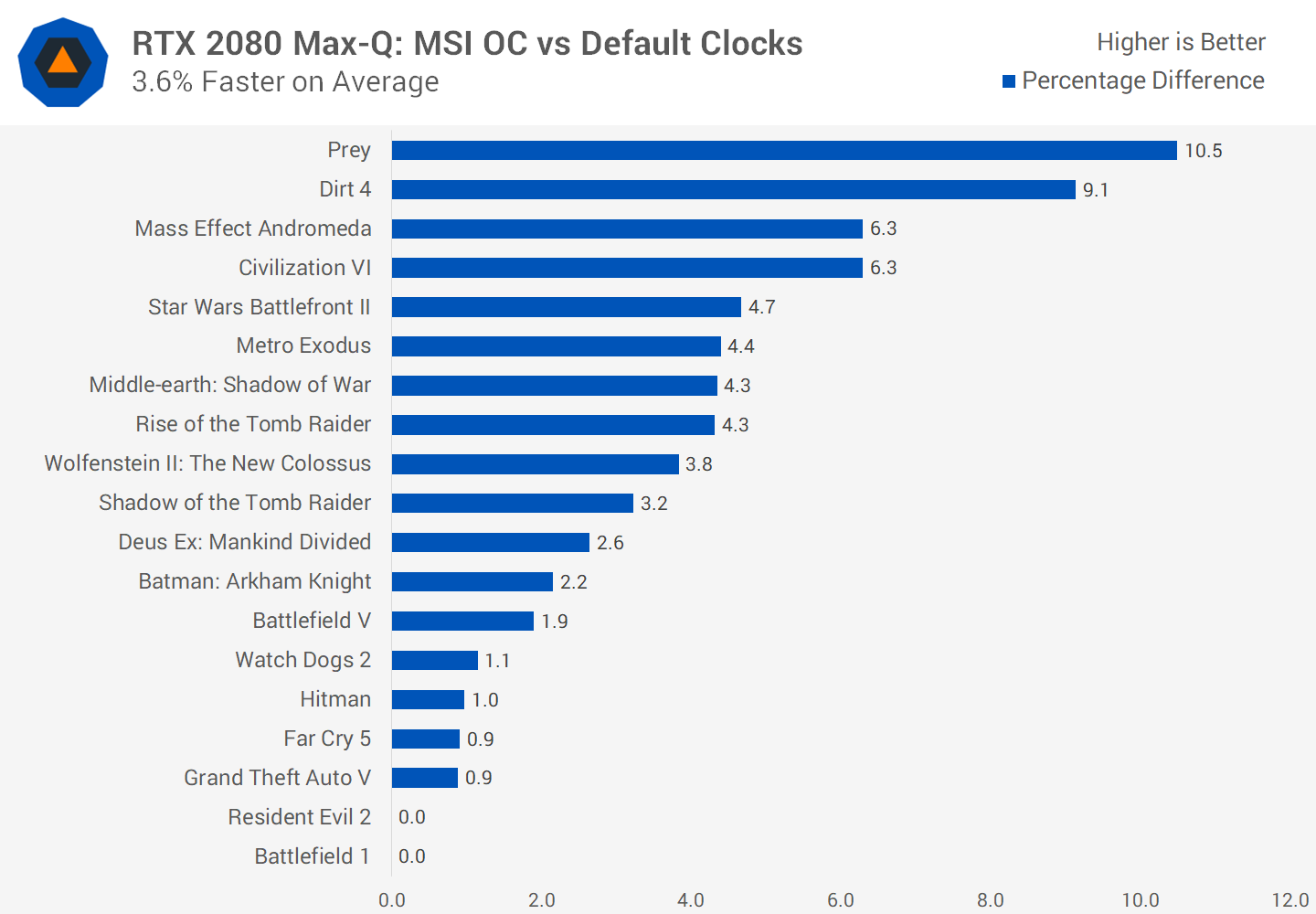
The best reason to use Turbo mode is that it improves gaming performance by 3 percent on average. It's not enough to get the RTX 2080 Max-Q in its standard 80W config to reach the performance levels of the 90W version, but it's a handy boost over stock performance that you can essentially access with a single click. And depending on the game you play, you could see up to a 10 percent improvement, which is impressive.
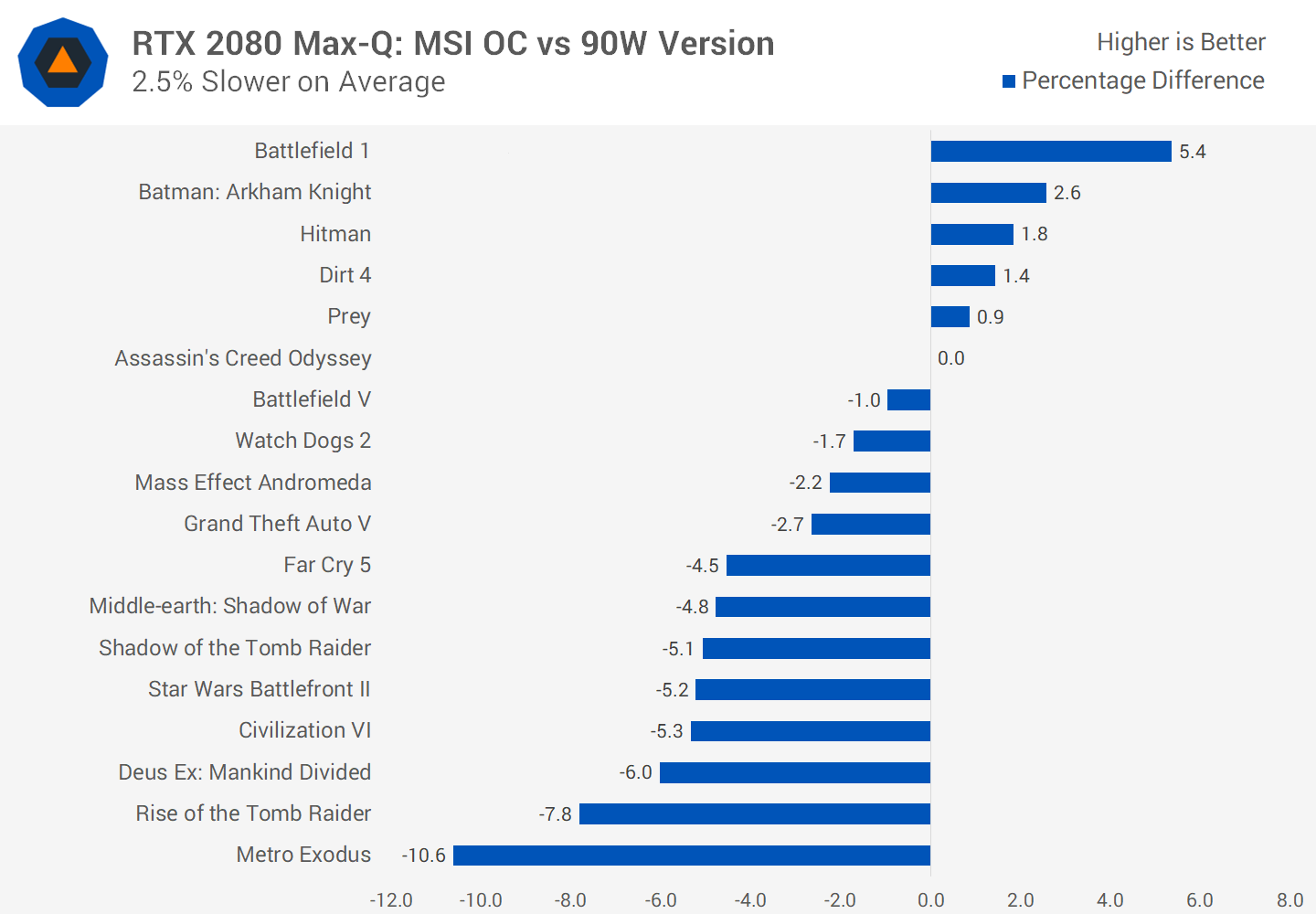
How does this Turbo performance stack up to other GPUs? Well, let's take a look. As we mentioned, we're sitting about three percent behind the 90W configuration of the RTX 2080 Max-Q, not a massive gap but laptops that do include the higher TDP variant deliver better performance. Unfortunately, there's no easy way to tell which laptops are 90W models.
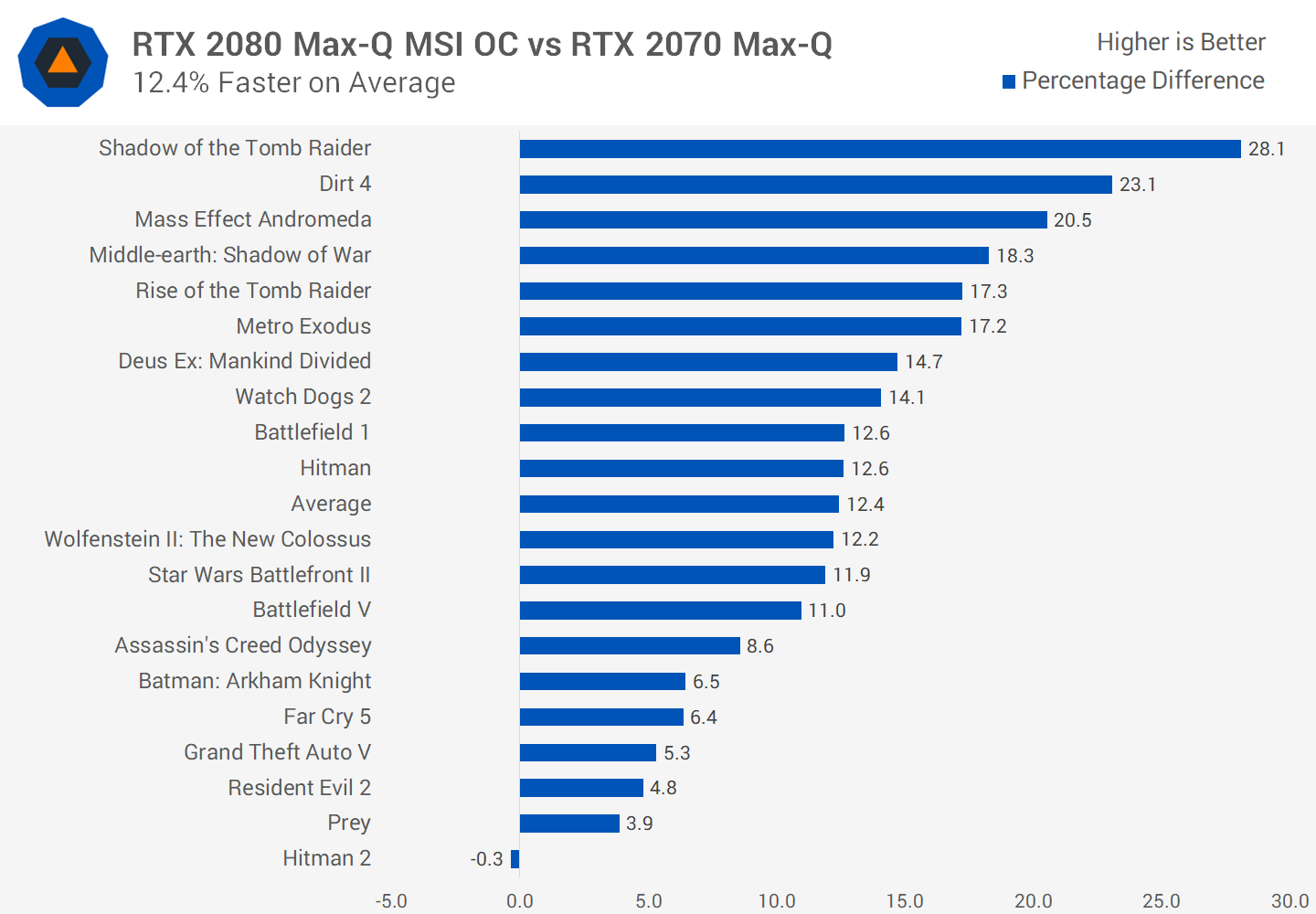
We're getting 12 percent more performance from the GS75 than a standard RTX 2070 Max-Q laptop without any factory overclocking. Some games are heavily constrained by the CPU or other hardware, like Hitman 2, while other such as Metro Exodus deliver 17 percent more performance. You're not getting desktop-like margins here, but low double digit gains from the same cooler design isn't bad.
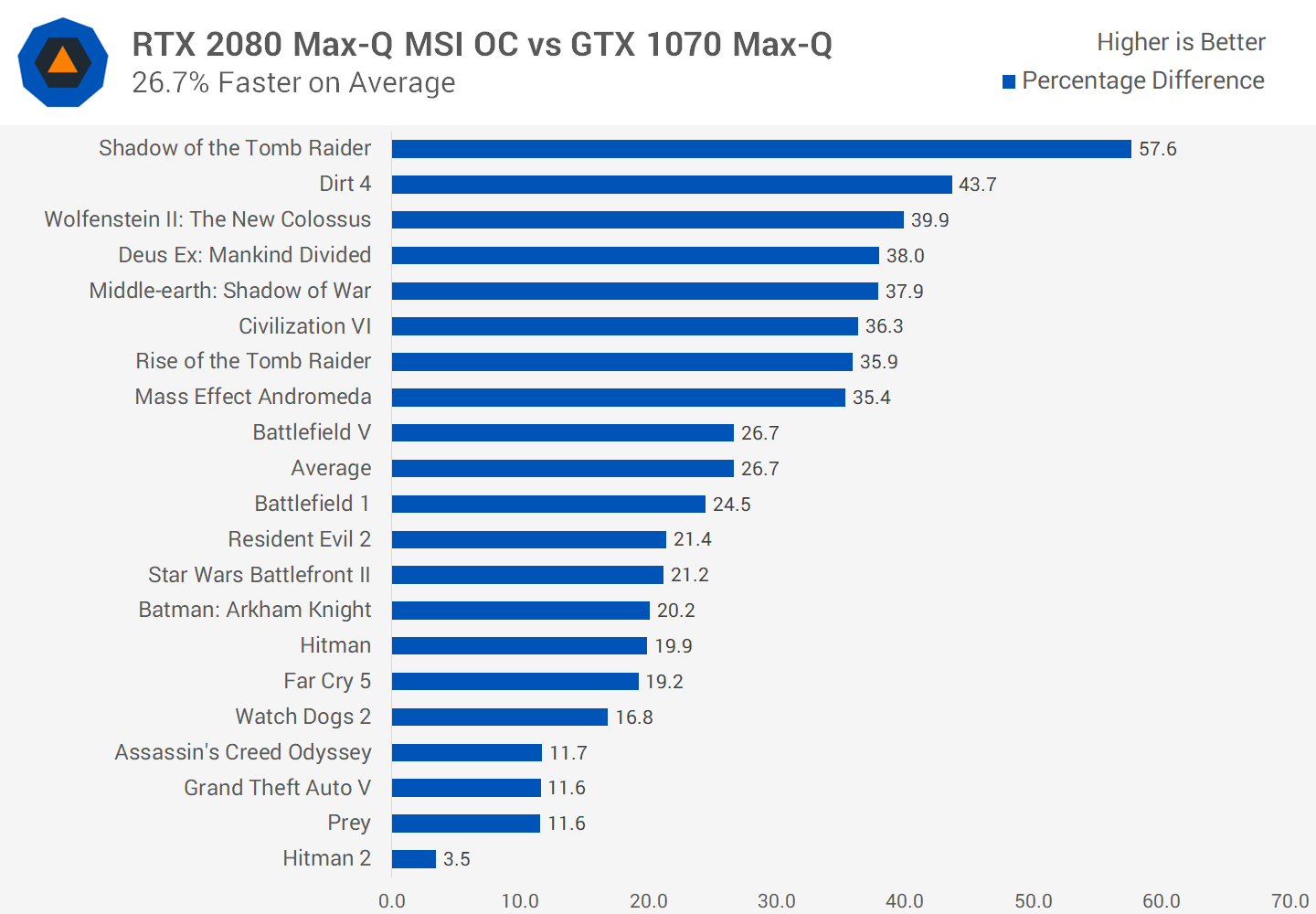
How does 27 percent more performance than the GTX 1070 Max-Q sound? That's a very healthy improvement assisted by the small factory overclock provided by the GS75. We're not comparing the same price bracket, but we suspect some people with a GTX 1070 Max-Q laptop might be considering spending a bit more cash on their next upgrade.
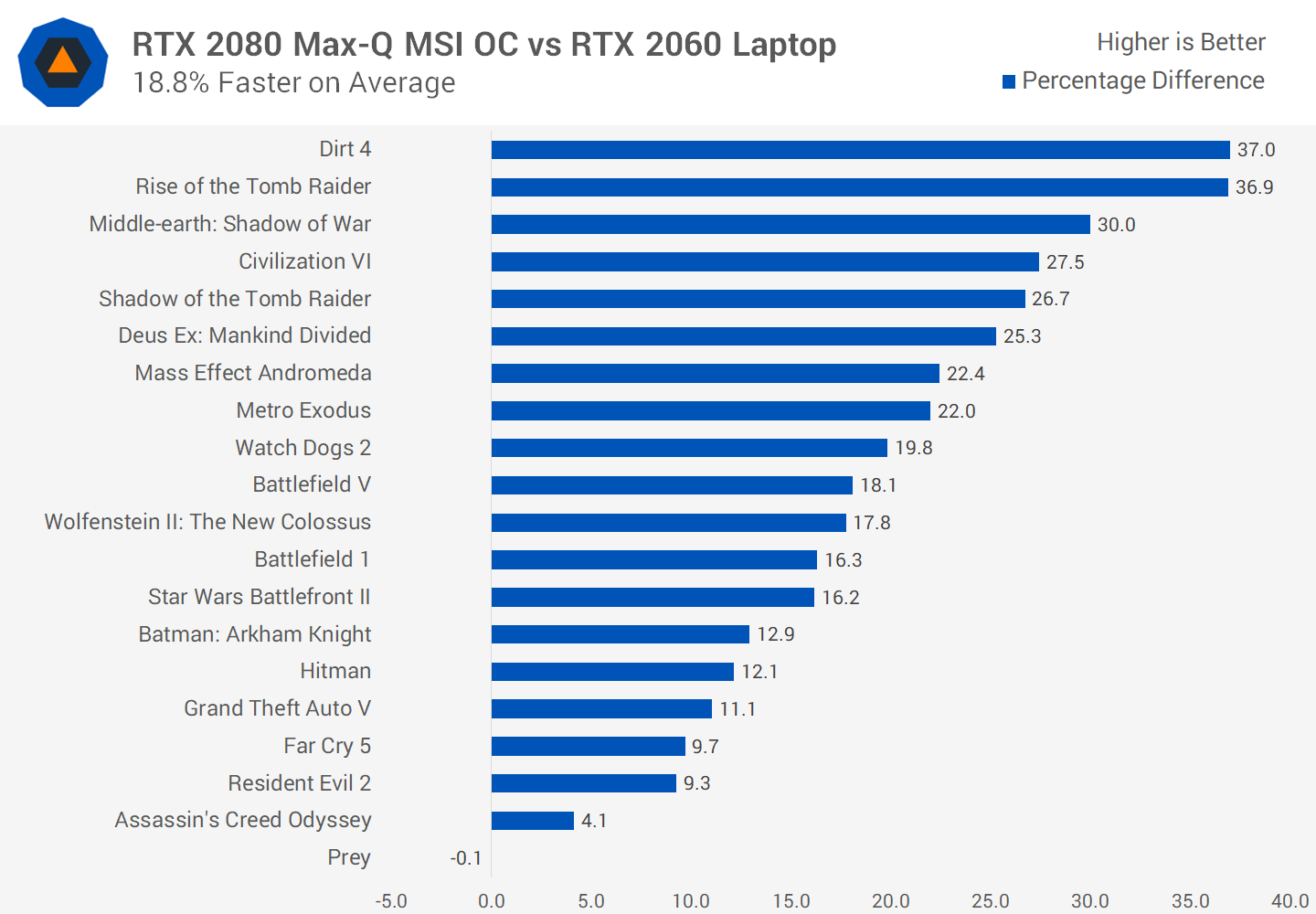
You'll also get 18% more performance than an RTX 2060 laptop. This is another GPU that's available in the MSI GS75, so which GPU is best might come down to the pricing you can get for each variant. The RTX 2080 Max-Q is a decent amount faster.
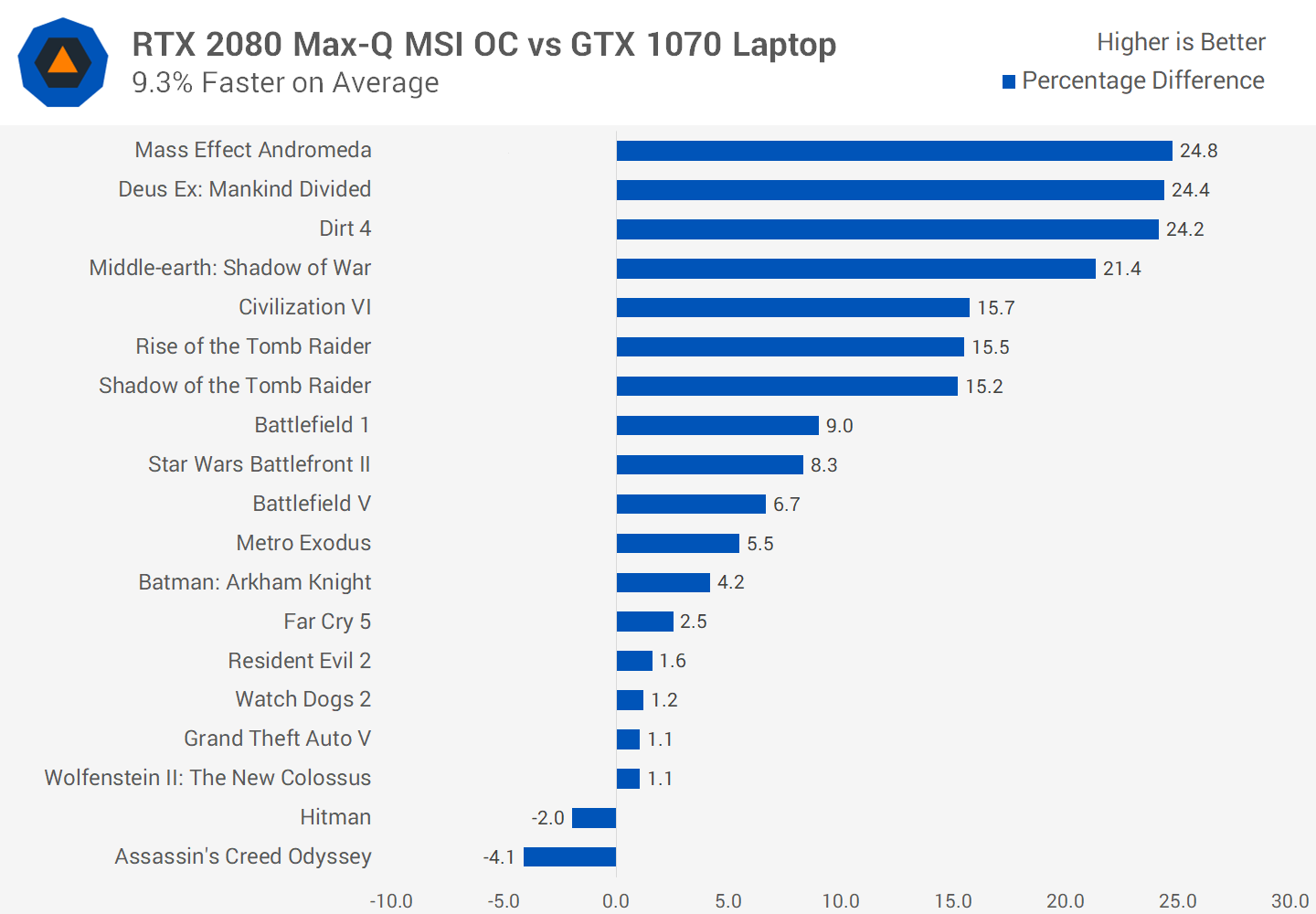
And finally a comparison to the Pascal GTX 1070 for laptops, which wasn't usually found in laptops of this size and weight, but still is a relevant comparison. The RTX 2080 Max-Q is only providing 9% more performance on average, and doesn't win in every title, though in some titles it is significantly faster. It's not a bad upgrade, but it's not near the performance gain you can expect moving from a desktop GTX 1070 to a desktop RTX 2080.
Cooling
MSI's current-generation triple-fan cooling solution is very good, it's definitely one of the better designs we've seen for this sort of portable gaming system. Even when using the overclocked Turbo mode, the GS75 is quieter than your average gaming laptop, at 44.5 dBA. And it does this while keeping the GPU around 75 degrees C, which is cooling performance you'd normally expect from a chunkier laptop like the ROG Strix Scar II, not a slim system like this.
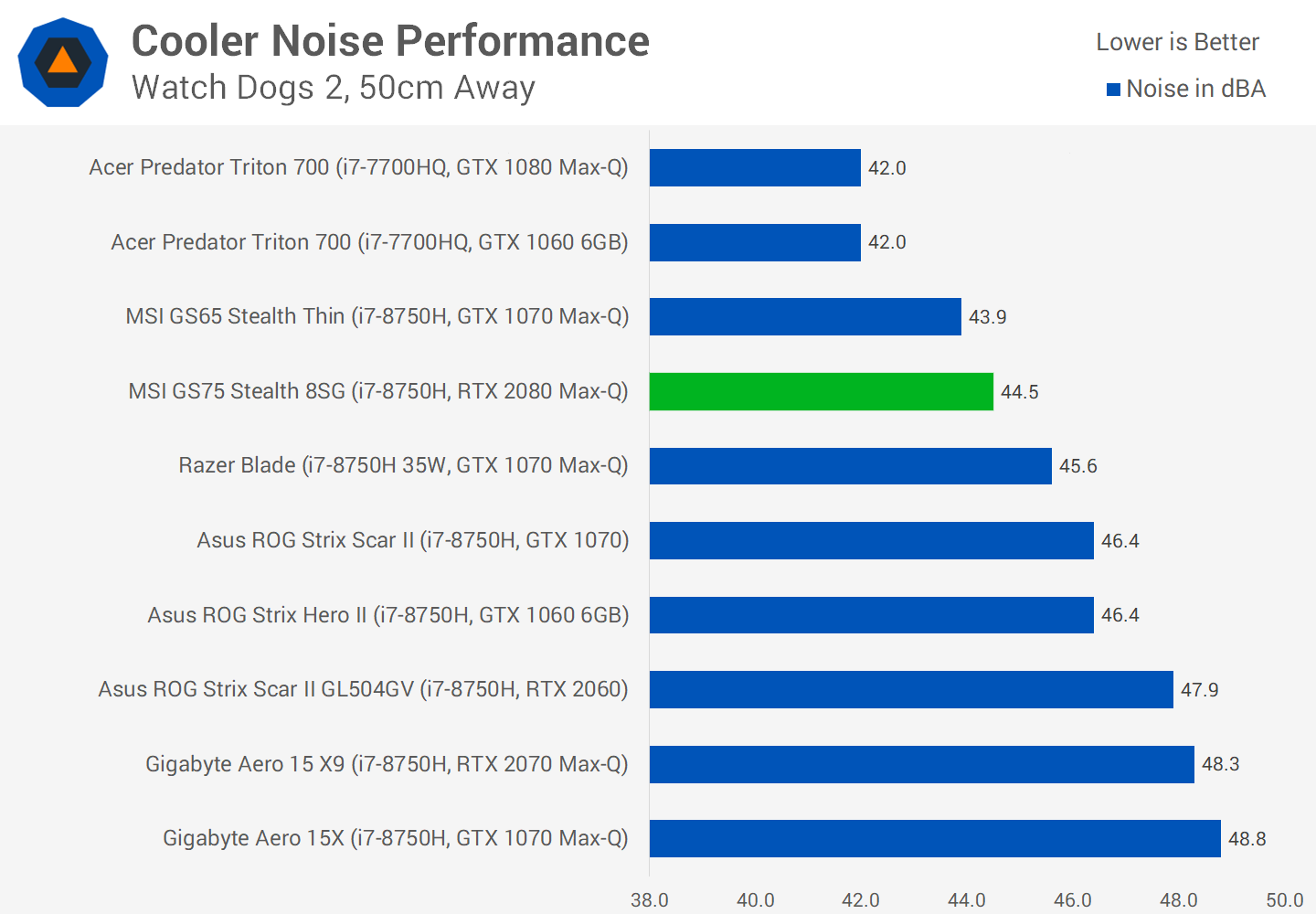
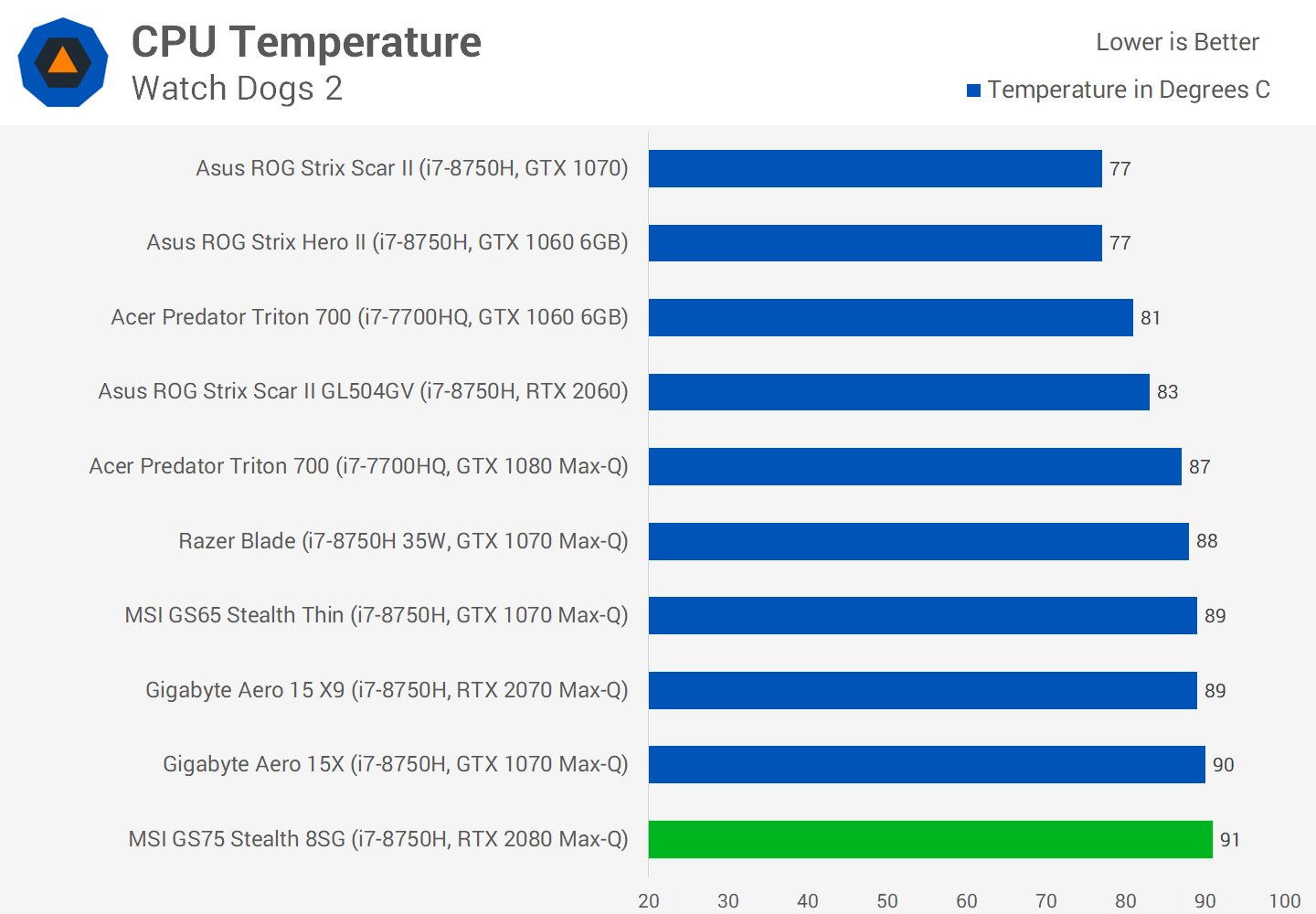
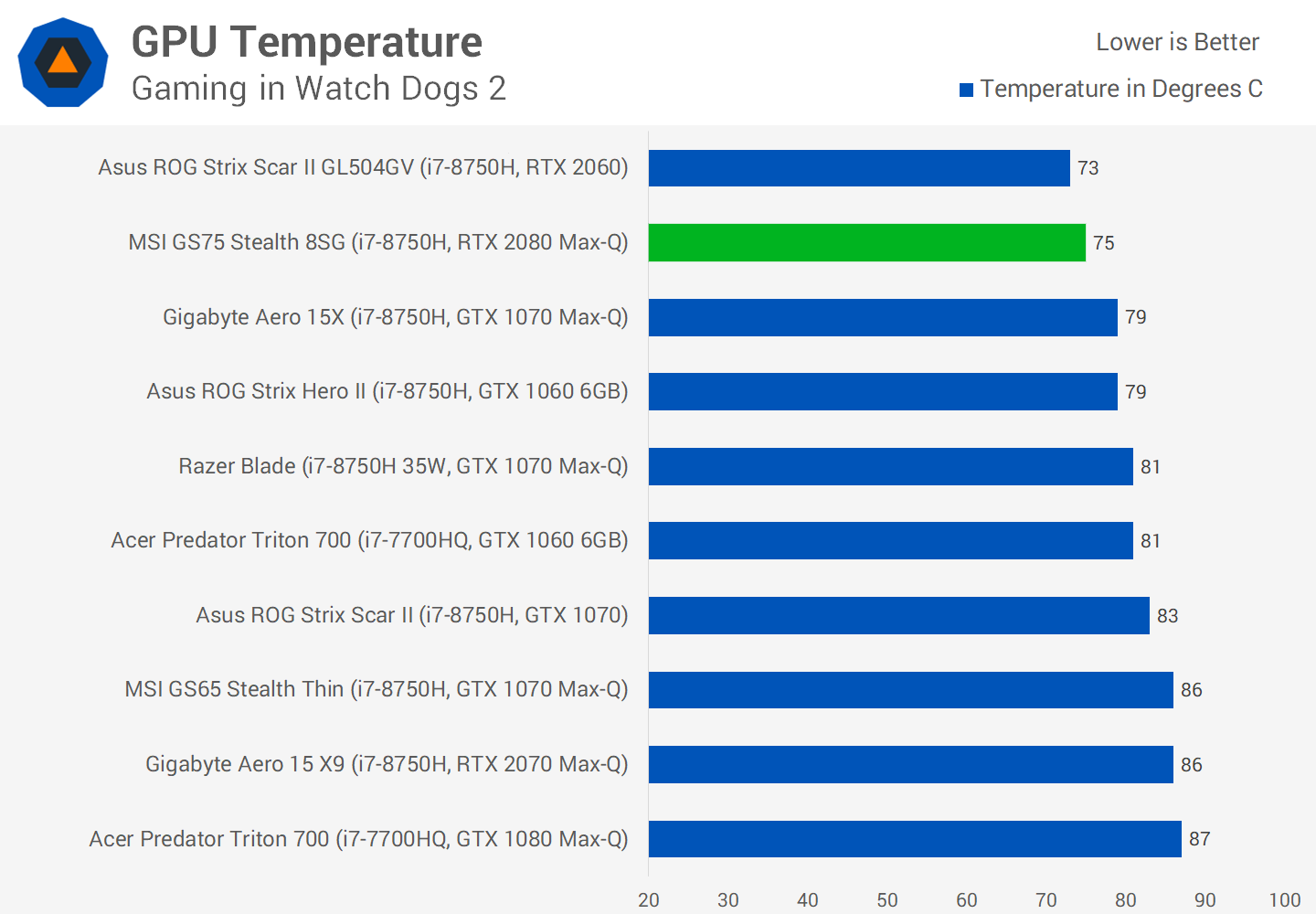
In fact, the GS75 is significantly better it this regard than the GS65 with the GTX 1070 Max-Q, although it is slightly louder, it's also a larger system so there's more room for heat dissipation, and the GPU is different. More impressively, it's quieter and cooler than the Gigabyte Aero 15 X9, which uses the slower RTX 2070 Max-Q. However, this does come at the cost of CPU cooling, which is right at its limit, hitting 91 degrees C under a gaming load.
Surface temperatures as well were manageable, the laptop gets quite hot above the keyboard where there is some ventilation, however the keyboard area and wrist rests were comfortable to use during an extended gaming session. Just make sure you don't place anything that melts around the back or sides of this laptop, because the extensive venting holes do push out a fair volume of hot air.
Storage Performance
Looking at storage performance, the GS75 we received with 1TB of SSD space was configured with two Samsung PCIe NVMe drives in RAID 0, so naturally it delivered extremely good sequential speeds. Random performance is at the limit of these drives but is still excellent for a gaming laptop, and it's safe to say this SSD is much faster than what you need for game loading.
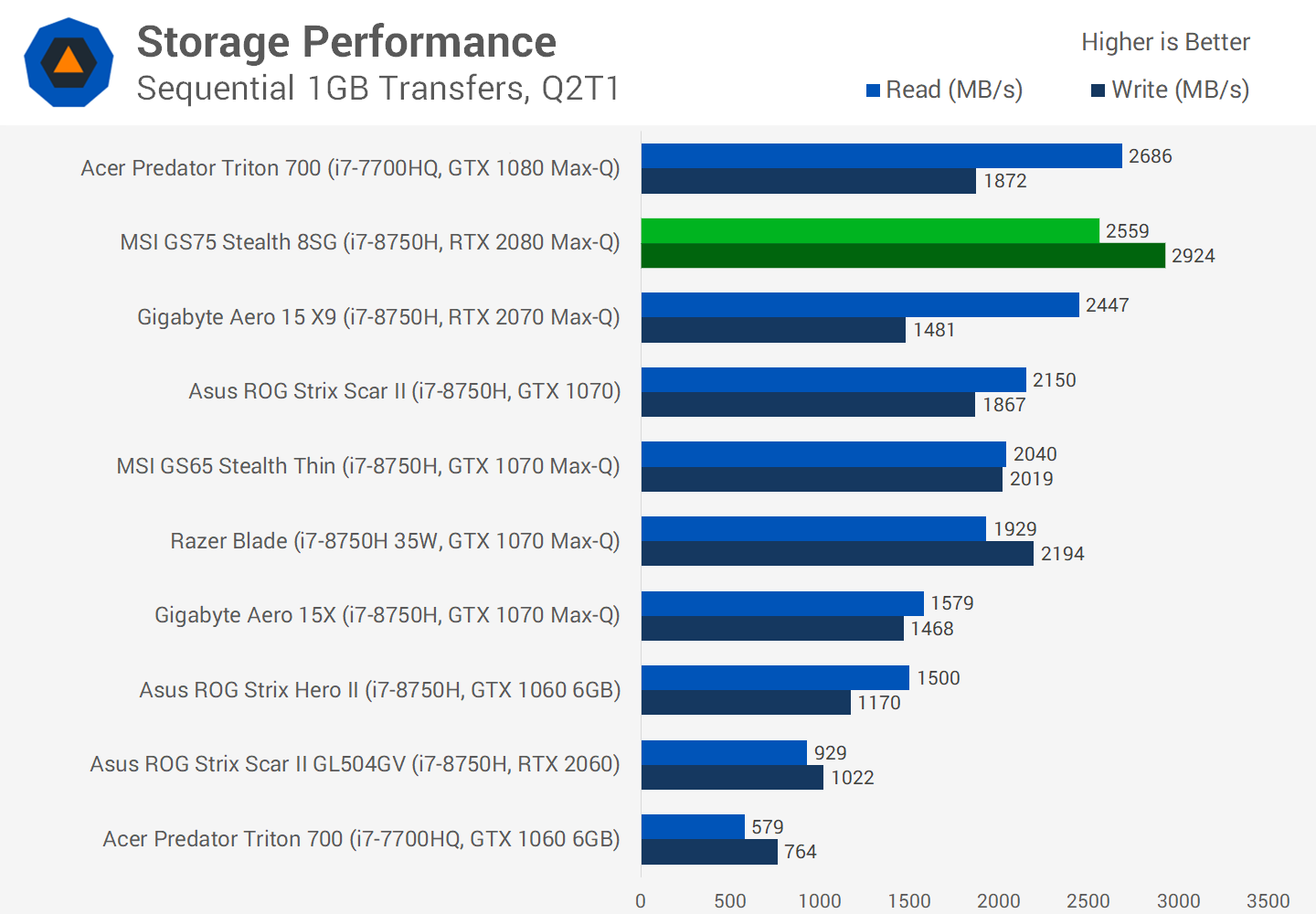
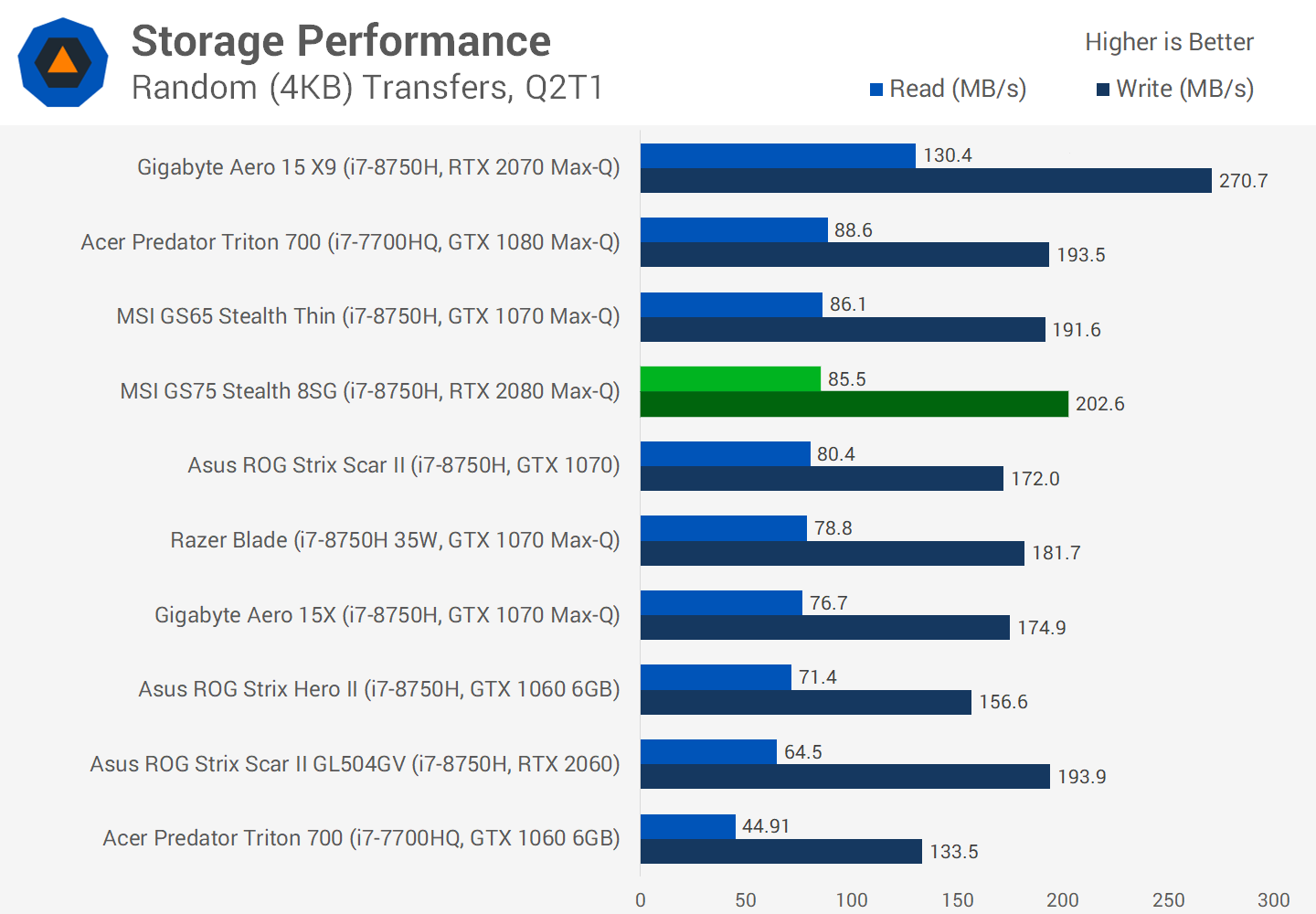
When removing the bottom cover you get easy access to the two loaded SSDs as well as an additional third M.2 slot, which was free in our unit, so there's further room to upgrade the storage in the future. This is also a better internal design than the last-gen GS65 we looked at, which had no access to storage without further deconstruction.
However there are a few disappointing aspects to the internal layout here. Because MSI is still using a flipped motherboard, you can't access the RAM without taking the entire motherboard out, which is tricky and time consuming. Hopefully the models that come with 16GB of RAM include it in a dual-channel configuration for the best performance, because if it's single channel, it will be hard to fix.
There's also no 2.5-inch drive bay so you're stuck with just M.2 slots for storage upgrades. Perhaps not the biggest deal given this is a high-end laptop and there's a generous three M.2 slots, but it would have been nice given this is a 17-inch notebook.
Battery Life & Display Quality
Battery life is pretty good from the 82 Wh battery, despite the use of a 17-inch high refresh display. In our video playback test it performed around the same mark as other 15-inch laptops of this type, which I'd say is a good result.
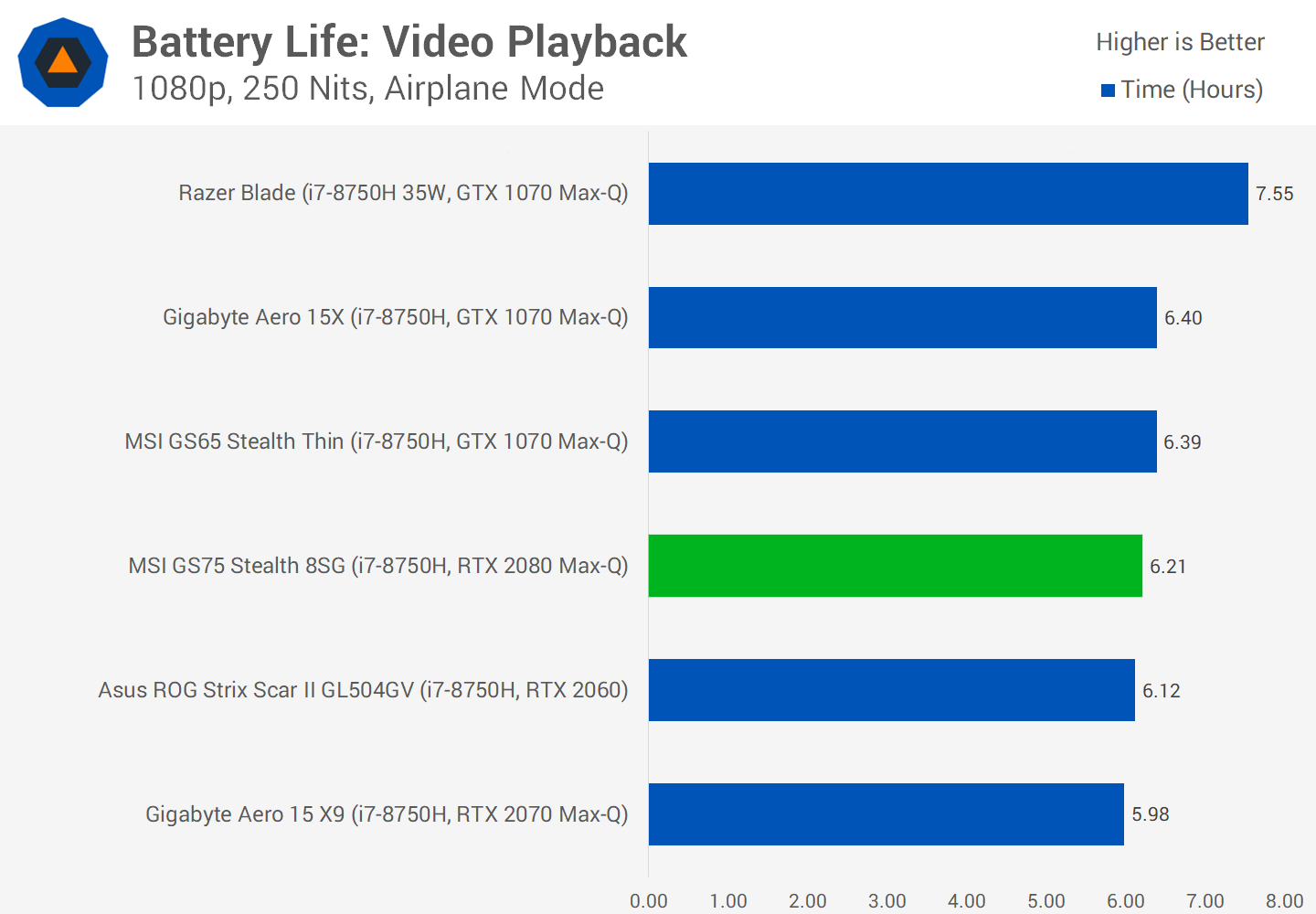
The display is 17.3-inches in size, it packs a 1080p resolution and it has a 144 Hz refresh rate. You don't get adaptive sync, which is a trade-off to allow better battery life through GPU switching, but the quality of this panel is great and the high refresh rate is a perfect pairing for this GPU that often pushes frame rates above 100 FPS at 1080p with Ultra settings.
Brightness is very good, at over 400 nits, while the contrast ratio of 1000:1 is typical for a laptop IPS. And because it's IPS, you get great viewing angles with acceptable response times. But what we feel is the best aspect to this display, is MSI's color calibration. When using the sRGB mode available through MSI True Color, you're getting an accurate white point around 6500K, plus strong deltaE averages in our saturation and ColorChecker tests, where the display falls under 2.0. It's not perfect due a greyscale deltaE average a little above 2.0, but otherwise this is an excellent result for a gaming laptop display.
Closing Remarks
Overall the MSI GS75 Stealth 8SG is an excellent portable gaming laptop. There's not a lot to complain about in regards to the hardware package. We absolutely love the metal chassis, the 15-inch display is very good, it's cooler and quieter than an average gaming laptop despite the size and powerful hardware inside, and there's good I/O.
It's even better from a performance perspective. Surely we've criticized the RTX 2080 Max-Q on a number of fronts like the naming confusion, how it stacks up to desktop parts and so on. But purely looking at its standalone performance, it's impressive what it can do in this sort of form factor.
It's great for 1080p high refresh gaming and very solid for higher resolutions using external displays, in the latest games at Ultra settings. The Core i7-8750H is also perfect for productivity tasks on the go like video editing. Right now, this is the fastest hardware you can get in this form factor.
Most of our criticisms of this laptop feel like minor nitpicks relative to the overall quality of the system. The keyboard is a little spongy, the I/O layout isn't the best, and the 8750H is a little slower than average in longer workloads. But overall, looking just at the hardware, there's no doubt this is a great gaming laptop and one we'd recommend.
Unfortunately, this hardware comes at a price, and it's a high one. To get top-end performance in this size, you're going to need to fork out $2,800, and that's just for the GS75 with a 256GB SSD and 16GB of RAM. For the configuration we reviewed, with a 1TB SSD and 32GB of RAM, it's closer to $3,000.
It's hard to justify spending that sort of money on the RTX 2080 Max-Q, because you're paying a massive premium to get this flagship-level performance. The RTX 2070 Max-Q version of the same laptop is $400 cheaper, meaning it delivers about 10% less performance for a 14% lower price. The RTX 2060 model is even better relative value at $2,100, so 25% cheaper for 14% less performance. Whether spending an extra $700 is worth it to get 10 to 20 FPS more is up to you.
The value situation is further muddied by Pascal laptops, which admittedly are getting harder to find as stock clears out. Right now you can get a GTX 1070 Max-Q system like the Asus ROG Zephyrus S for around $1,800, which is slightly better value than the RTX 2060 GS75, given the 1070 Max-Q is also slower.
It's an interesting market, because for regular laptops - meaning, not the slim and light variants we've been talking about so far - we wouldn't recommend a more expensive RTX 2060 laptop over a cheaper GTX 1070 laptop right now. But for slim and light systems, the GTX 1070 Max-Q and RTX 2060 are fairly priced given their performance differences. What is the better option will be down to your budget, though we tend to like a lot the value offered by the RTX 2060 GS75 just because we love this MSI design and its 17 inches for playing games.
